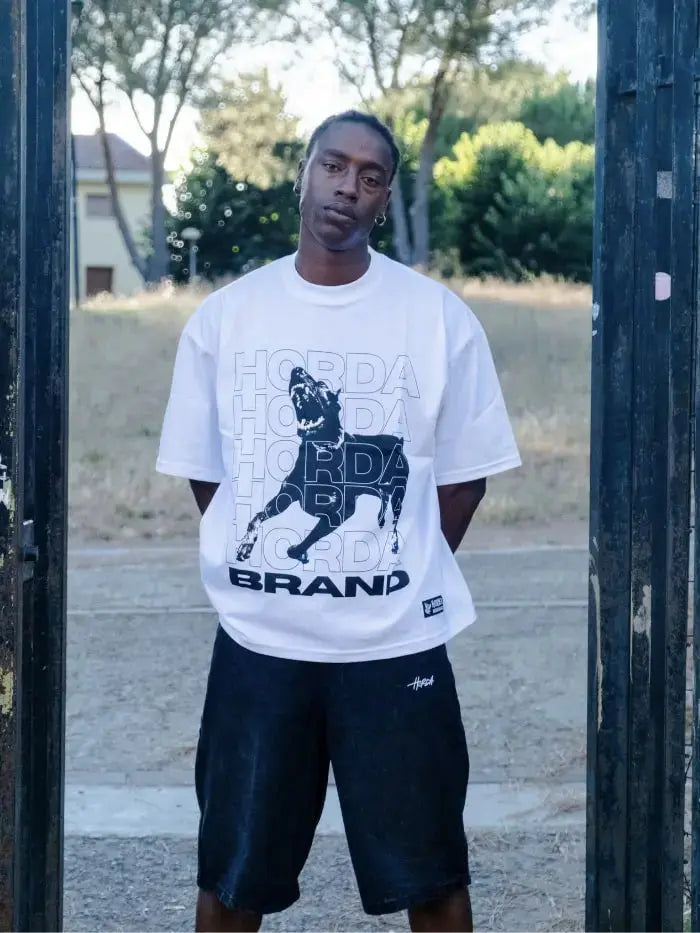Boxy fit T-shirts have become a staple in contemporary streetwear . With their boxy silhouette, broad shoulders, and loose fit, they offer a comfortable and cool style, perfect for an urban wardrobe. In this article, we'll delve into what they are, how to measure them, their history, and why they've become so popular in the world of casual fashion.
What does “boxy fit” mean?
The definition of “boxy fit” comes from the shape of the t-shirt: literally “box-like”. Compared to the classic fit ( regular fit ), the boxy fit :
-
It has a loose silhouette , often with a straight cut
-
The shoulders are extended beyond the natural shoulder
-
The body is broad at the chest and abdomen
-
The length can be slightly shorter (crop-boxy) or standard
This silhouette prioritizes comfort and a relaxed aesthetic, making it instantly recognizable.
Typical measurements and how to orient yourself
Boxy fit t-shirts do not follow rigid standards, but generally these measurements are considered (expressed in centimeters or inches, to be adapted to the target market):
| Fit | Shoulder (total width) | Chest (width of torso) | Length (from shoulder to bottom) |
|---|---|---|---|
| XS‑S | 48–52 cm | 55–60 cm | 60–65 cm |
| M‑L | 52–56 cm | 60–65 cm | 60–67 cm |
| XL-XXL | 56–60+ cm | 65–70+ cm | 62–69 cm |
How to interpret these measures :
-
Shoulder : Measure from one seam to the other, across the shoulder-to-shoulder point.
-
Chest : Measure at the mid-section of the tank top/breast under the sleeves, including the front/back.
-
Length : from shoulder-neck seam to hem.
The boxy fit is designed to be intentionally loose: if there's a 5–10 cm difference at the shoulder or chest between your measurements and the ones provided, it's probably intentionally designed that way. For those seeking a truly boxy fit, simply choose a standard size and interpret the boxy effect, perhaps comparing it with your own wardrobe.
A bit of history
The boxy fit has roots in the '80s and '90s, when hip-hop and skate fashion began to dominate urban environments. Loose-fitting, clean-cut T-shirts were not only comfortable for dancing, skating, and moving around the city, but also made a statement.
-
Hip-hop and street culture : artists and crews like Crew 5 have made wide, boxy silhouettes famous.
-
Skate and surf : The skate community loved the comfort of the loose-fitting garment, which offered freedom of movement and an anti-mainstream spirit.
-
High-end streetwear fashion : Brands like A Bathing Ape, Off-White, Supreme, and Fear of God helped bring the boxy fit to the runways and luxury street collections.
Today, the boxy fit has become a key element not only among cult streetwear brands, but also among contemporary fast fashion and urban luxury lines.
Why Boxy Fit is Viral and Loved Online
There are several reasons why boxy fit has gone viral:
-
Instagram-friendly aesthetic : clean silhouettes, sharp cuts, balanced proportions: flat-lay photos (T-shirt laid flat) or streetwear outfits work very well.
-
Comfort performance : free space on shoulders and chest, natural ventilation, ideal for layering and urban and sporty looks.
-
Stylistic versatility : it can be easily paired with cargo trousers, joggers, Bermuda shorts, midi skirts and chunky sneakers.
-
Generational appeal : transgressive pleasure versus the Pilates-perfect look of the mainstream image. Influencers, TikTokers, and urban creatives often use them to "break the grid"—the boxy look breaks the visual monotony.
-
Accessibility and replication : Global chains such as Uniqlo, H&M and Zara offer boxy fits at affordable prices, amplifying the diffusion
